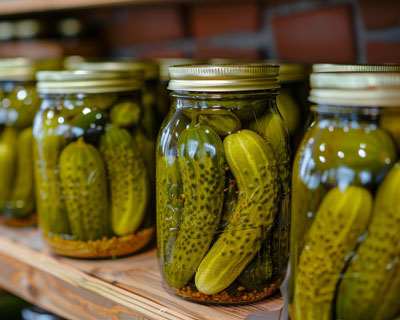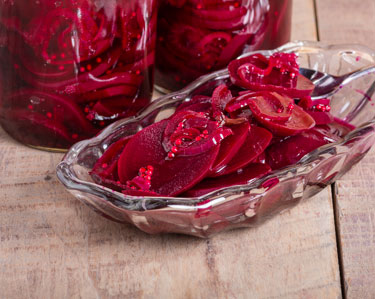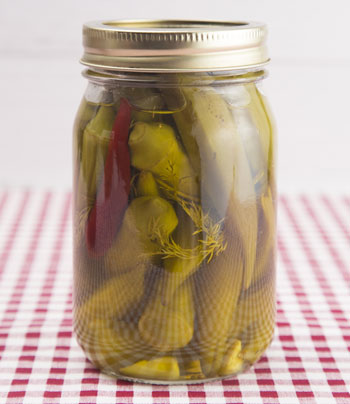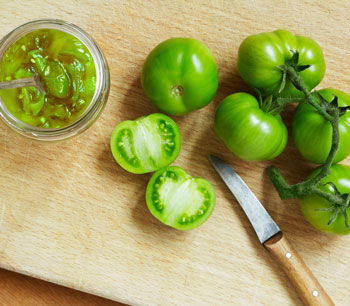Quick Process Pickles
Introduction to Pickling
 Pickled products of all types are a staple in any southern home. Whether you gather
fruits and vegetables from your own garden, farmers market or grocery store, pickling
is a quick and easy way to preserve Arkansas’ summer bounty. All pickled products
have a distinctive sour or sweet and sour taste.
Pickled products of all types are a staple in any southern home. Whether you gather
fruits and vegetables from your own garden, farmers market or grocery store, pickling
is a quick and easy way to preserve Arkansas’ summer bounty. All pickled products
have a distinctive sour or sweet and sour taste.
There are two ways to safely make pickled products at home. The first is a quick process pickling method, and the second is fermentation. This publication focuses on the quick pickle process.
The quick process pickle method relies on adding acid in the form of vinegar and then processing the jars for a specified amount of time in a water bath canner. The unique flavor of pickled products comes from the pickling liquid which is a mixture of water, vinegar, spices and seasonings.
Sometimes products are brined in a salt solution for several hours prior to processing to enhance crispness and flavor. Since the flavor of quick process pickles comes from the pickling liquid, pickled products will have a better flavor if they are allowed to stand for several weeks after they have been properly sealed in the jars.
Pickling Liquid Basics
Salt
When processing your pickled products, be sure to use pure granulated salts such as “canning” or “pickling” salts. Other salts contain an anticaking agent that can alter the clarity of your liquid and iodine which can make pickles dark. The calcium silicate present in commonly used table salts can cause settling at the bottom of the jar or clouding. Salts that are recommended for canning purposes should be readily available at local grocery, hardware or farm stores. Kosher salt typically does not contain anticaking agents or iodine and may be used, but check the label for additives.
Vinegar
Vinegar is the essential ingredient in the quick pickle process that ensures your
homecanned products
are safe. It is important to use white or cider vinegars with 5 percent acidity. Vinegars
with 5 percent acidity are the most common in commercially sold vinegars. Use white
distilled vinegar if you are concerned about the look of your pickled products, and
cider vinegar will give your products a great flavor. Do not use homemade vinegars
or other vinegars of unknown acid levels. Again, vinegar in the pickling liquid ensures
that your pickled products can safely be canned using a water bath method. It is important
not to alter the amount of vinegar listed in the recipe.
Sugar
Sugar is a flavoring agent in the quick pickle process and is important for food safety. Use a white sugar instead of a brown sugar, unless your recipe calls for it. Using a white sugar will ensure a clear product; however, a brown sugar may be desired for a certain flavor. If you would like to use a sugar substitute, some recipes are available. Only use those recipes that call for the substitute since sugar helps with keeping foods safe. It is not appropriate to swap regular sugar for the substitute in other recipes. Also, do not alter the amount of sugar listed in the recipes.
Spices and Seasonings
For the best flavor, use fresh whole spices and seasonings. To customize your recipe, you may add more or less of the spices listed in the recipes found here. For example, you may add more dill seed and less mustard seed depending on your taste preference.
Water Bath Canning Basics for Pickling
In order for your pickled products to maintain their quality and safety, you need to process them in a water bath canner for a specific amount of time. It is important to process all pickled products stored at room temperature to ensure that yeasts are destroyed as well as molds and bacteria that can cause spoilage and to inactivate enzymes that could affect the texture, flavor and color of the pickled products.
General instruction for the water bath canning method:
- Wash all equipment, including jars specifically made for canning and bands, with hot,
soapy water and rinse well or wash in dishwasher. If detergent isn’t completely rinsed,
product may taste soapy. Set equipment aside on clean towels for later use.
- Fill water bath canner with clean water to approximately the level needed for a canner
load of jars. Water level should be 1 to 2 inches above the jars. Turn on heat and
bring to a simmer. Add clean jars to water and open side up to keep warm.
- In a small stockpot, bring clean water to a boil. This is to add extra to your canner
if needed.
- Prepare lids per manufacturer’s instructions.
- Follow your recipe’s instructions for preparing your product and pickling liquid.
-
When ready, use clean tongs to remove the glass jars and drain. Place the jars on a dishtowel or paper towels.
-
Ladle the hot pickle mixture into the jars, filling the jars (recommend using a canning funnel) until there is ½ inch headspace. Headspace allows contents to expand without ruining the seal during processing. When there is not enough headspace, contents can boil over and prevent jars from sealing. Too much headspace can lead to a poor vacuum seal since processing time may not be long enough to drive out all the extra air from the top of the jar.
-
Wipe the jar rims clean with a clean damp towel or paper towel.
-
Put lids in place and screw on bands until just tight.
-
Process by returning the filled jars, lid side up, to the water bath canner. The water should be simmering but not boiling. Also, be sure the jars don’t touch each other or the pot. Add additional hot water, if necessary, to cover the jars by 1 to 2 inches.
-
Bring water to a rolling boil, and once a rolling boil has been reached, boil for the specified time in the recipe.
-
Turn off heat and wait 5 minutes. Then remove from water and place jars on a cutting board or folded towel and let sit 12 to 24 hours.
Recipe Basics
Choosing the correct recipe is very important when preserving your food using the quick pickle process. This not only affects your safety but also the safety of your family and friends. Use recipes from sources that thoroughly test for acidity levels and safe internal jar temperatures. Recipes provided by Cooperative Extension Service have been tested to be safe.
Average Yield for Quick Process Pickles
- About 14 pounds of product needed per canner load of 7 quarts.
- About 9 pounds of product needed per canner load of 9 pints.
Storage
Label your jars with the product name and date of canning then store products in a cool, dry, dark place. Properly processed pickles are best when used within a year and are safe as long as the jar is sealed.
Tips and Tricks
- When selecting cucumbers for pickling be sure to select a pickling variety. Using “slicing” or “tasting” cucumbers will not yield the same quality of pickles.
- For a good selection of pickling cucumbers, you can use seed catalogs.
- For the highest quality, plan to pickle fruits or vegetables within 24 hours of harvesting.
- Before pickling, sort the fruits and vegetables by size for the selected recipe. Having the same size product will make your jars pretty.
- Wash the produce well, especially around the stems; these can hold soil
that has bacteria that can soften your pickles. - When preparing vegetables, be sure to remove ¹/16 inch of the blossom end. The blossoms
also contain an enzyme that can be responsible for softening.
- Pickling liquids should only be heated in an aluminum, glass, stainless steel or unchipped enamelware saucepan. Copper, brass, galvanized or iron utensils can react with the acid and salts. This causes an undesirable color change in the pickles.
- Use jars that are specially design for canning in half-pint, pint or quart size when pickling and don’t overprocess.
- The longer you cook your food, the softer your product will become, and the larger
the jar, the longer the processing time.
- If good quality produce and proper canning methods are used, firming agents won’t
be necessary
for crisp pickles. - You can soak cucumbers in ice water for 4 to 5 hours before pickling for crisper pickles.
- Finally be sure that your jars are warm when filling them with your hot food. Jars are more likely to break when hot liquid and products are added to a cold jar.
Recipes
Quick Fresh-Pack Dill Pickles
About 7 to 9 pints
- 8 pounds of 3 to 5inch pickling cucumbers
- 2 gallons of water
- 1¼ cups canning salt (divided)
- 1½ quarts vinegar (5 percent)
- ¼ cup sugar
- 2 quarts water
- 2 tablespoons whole mixed pickling spice
- About 3 tablespoons whole mustard seed
- About 14 heads of fresh dill or 5 tablespoons dill seed
- Rinse cucumbers. Cut ¹/16inch slice off blossom end and discard. Leave ¼ inch of stem attached. Dissolve ¾ cup salt in 2 gallons of water. Pour over cucumbers and let stand for 12 hours. Drain.
- Combine vinegar, ½ cup salt, sugar and 2 quarts water. Add mixed pickling spice tied in a clean white cloth. Heat to boiling.
- Fill jars with pickles. Add 1 teaspoon mustard seed and 1½ heads fresh dill (or 1½ teaspoons dill seed) per pint jar.
- Cover with boiling pickling solution, leaving ½inch headspace. Remove air bubbles. Wipe jar rims. Adjust lids.
- Process 10 minutes for pints or 15 minutes for quarts in a boiling water bath.
Quick Sour Pickles
About 8 pints
- About 25 cucumbers, mediumsized
- ½ gallon cider vinegar (5 percent)
- 2 cups water
- ½ cup canning salt
- ½ cup sugar
- ½ cup mustard seed
- Wash cucumbers. Remove ¹/16inch slice from blossom ends and discard. Slice cucumbers lengthwise. Pack into hot jars, leaving ½inch headspace.
- Mix vinegar, water, salt, sugar and mustard seed and bring to a boil. Fill jar to ½ inch from top with boiling hot liquid.
- Remove air bubbles. Wipe jar rims. Adjust lids.
- Process 10 minutes in a boiling water bath.
Bread and Butter Pickle Slices
About 8 pints
- 6 pounds of 4 to 5inch pickling cucumbers
- 8 cups thinly sliced onions (about 3 pounds)
- ½ cup canning salt
- Crushed or cubed ice
- 4 cups vinegar (5 percent)
- 4½ cups sugar
- 2 tablespoons mustard seed
- 1½ tablespoons celery seed
- 1 tablespoon ground turmeric
- 1 cup pickling lime (Optional: Follow directions below for firmer pickles.)
Preparation Without Lime – Rinse cucumbers. Cut ¹/16 inch off blossom end and discard. Cut into
³/16inch rings. Combine cucumbers and onions in a large bowl. Add salt. Cover with
2 inches crushed or cubed ice. Refrigerate 3 to 4 hours, adding more ice as needed.
Preparation With Lime – Rinse cucumbers. Cut ¹/16 inch off blossom end and discard. Cut into ³/16 inch slices. Mix 1 cup pickling lime, ½ cup salt and 1 gallon water in a 2 to 3-gallon crock, glass or enamelware container.
CAUTION: Avoid inhaling lime dust while mixing the limewater solution. Soak cucumber slices in lime water for 12 to 24 hours, stirring occasionally.
Remove from lime solution, rinse and resoak one hour in fresh cold water. Repeat the
rinsing and soaking
steps two more times. Handle carefully, as slices will be brittle.
To Make Pickles:
- Add sugar and remaining ingredients to vinegar in a large pot. Boil 10 minutes.
- Add onions and welldrained cucumbers and slowly reheat to boiling. Fill pint or quart jars with slices, leaving ½inch headspace. Fill to ½ inch from top with hot cooking liquid. Remove air bubbles and adjust headspace if needed.
- Wipe jar rims. Adjust lids. Process pints or quarts 10 minutes in a boiling water canner.
- After processing and cooling, jars should be stored 4 to 5 weeks to develop ideal flavor.
Pickled Beets
 About 8 pints
About 8 pints
- 7 pounds of 2 to 2½inch diameter beets
- 4 cups vinegar (5 percent)
- 1½ teaspoons canning salt
- 2 cups sugar
- 2 cups water
- 2 cinnamon sticks
- 12 whole cloves
- 4 to 6 onions (2 to 2½inch diameter) (optional)
- Trim off beet tops, leaving 1 inch of stem and roots to prevent bleeding of color. Wash thoroughly. Sort by size. Cover similar sizes with boiling water and cool until tender (about 25 to 20 minutes). CAUTION: Drain and discard liquid.
- Cool beets. Strip off roots and stems; slip off skins. Slice into ¼inch slices. Peel and thinly slice onions. Combine vinegar, salt, sugar and fresh water.
- Put spices in cheesecloth bag and add to vinegar mixture. Bring to a boil. Add beets and onions.
- Simmer 5 minutes. Remove spice bag.
- Fill jars with beets and onions, leaving ½inch headspace. Add vinegar solution, allowing ½inch headspace; remove air bubbles; wipe jar rims. Adjust lids.
- Process pints or quarts 30 minutes in a boiling water bath.
Variation – For pickled whole baby beets, follow above directions but use beets that
are 1 to 1½ inches
in diameter. Pack whole; do not slice. Onions may be omitted.
Okra Dill Pickles

About 8 or 9 pints
- 7 pounds small okra pods
- 8 or 9 garlic cloves
- 2/3 cup canning salt
- 4 teaspoons dill seed
- 6 small hot peppers
- 6 cups water
- 6 cups vinegar (5 percent)
- Wash and trim okra.
- Fill hot pint jars firmly with whole okra, leaving ½inch headspace.
- Place 1 garlic clove in each jar.
- Combine salt, dill seed, hot peppers, water and vinegar in large saucepan and bring to a boil.
- Pour hot pickling solution over okra, leaving ½inch headspace.
- Remove air bubbles. Wipe jar rims. Adjust lids.
- Process pints for 10 minutes in a boiling water bath.
Pickled Green Tomato Relish
 About 2 half-pint jars
About 2 half-pint jars
- 10 pounds small, hard green tomatoes
- 1½ pounds red bell peppers
- 1½ pounds green bell peppers
- 2 pounds onions
- ½ cup canning salt
- 1 quart water
- 4 cups sugar
- 1 quart vinegar (5 percent)
- ¹/3 cup prepared mustard
- 2 tablespoons cornstarch
- Sterilize canning jars.
- Wash and coarsely grate or finely chop tomatoes, peppers and onions.
- Dissolve salt in water and pour over vegetables in large saucepot. Heat to boiling and simmer 5 minutes.
- Drain vegetables and return to saucepot.
- Add sugar, vinegar, mustard and cornstarch. Stir to mix. Heat to boiling and simmer 5 minutes.
- Fill hot pint jars with hot relish, leaving ½inch headspace.
- Remove air bubbles. Wipe jar rims. Adjust lids.
- Process 5 minutes in boiling water bath.
References
Complete Guide to Home Canning, United States Department of Agriculture, Agriculture Information Bulletin No. 539. Revised 2006.
So Easy to Preserve (Sixth Ed.), Cooperative Extension Service, The University of Georgia, Athens. Revised 2014. National Center for Home Food Preservation.